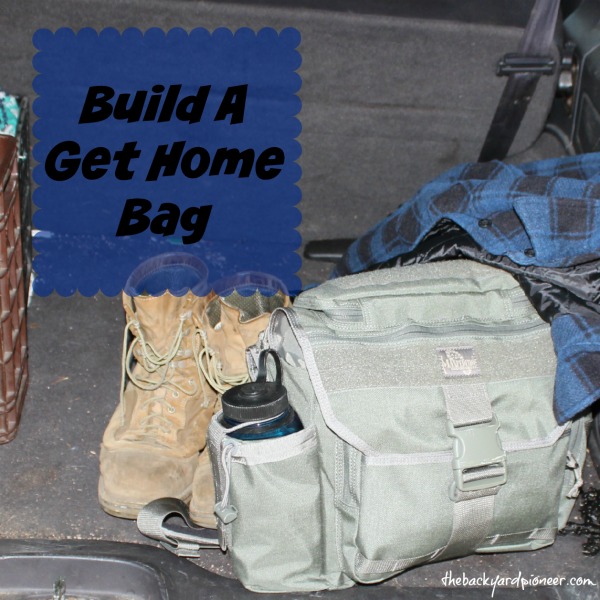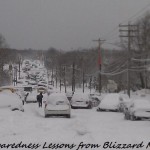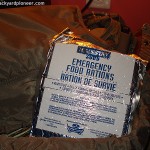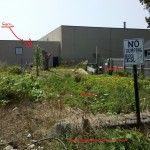A great project for common sense preparedness is setting up a Get Home Bag. You just need to look at the news to see several times a year, where due to natural or man made disasters people are forced to wait out a cold and uncomfortable night in their car, or need to abandon their vehicles and hoof it home. The wild winter storms in the Northeast and the South saw people having to seek shelter from the storm’s fury in Home Depots and Wal-Marts. 9/11 and the Blackout of 2004 had thousands on foot walking out of New York City. A Get Home Bag filled with some carefully chosen gear and supplies can help mitigate some of the uncertainty and add a whole lot of comfort to a trying time.
Build A Get Home Bag
When building a Get Home Bag it is important to understand what it is and what it isn’t. A Get Home Bag is a small and highly portable emergency kit. It is filled with gear and supplies that will sustain you on a walk or drive home in event of an emergency. It isn’t a Bug Out Bag (for a great post on Bug Out Bags check out Graywolf Survival) or a long term head for the hills bag. It won’t get you through the Zombie Apocalypse but it will keep you semi-comfortable on cold snowy night when you can’t get home or will put some food in your belly while walking home during a big blackout.
Choosing A Get Home Bag
One of the most important aspects of building a get home bag is choosing the actual bag. There are a few different styles of bag to choose from but the best bags all have some common elements.
- Tough– A good bag will be made of quality materials. It will be reinforced at the weak points and will have overbuilt zippers and buckles.
- Plenty of compartments– The best bags will have plenty of compartments and pouches. Having to dig through one large unorganized compartment in an emergency situation will only slow you down and frustrate you.
- Comfortable– Comfort is one of the most important elements of building a get home bag. If a bag is cool looking but uncomfortable you will be the one paying while it digs into your shoulder and makes for a miserable walk home if you do have to deploy it for real.
These are the key points to look for in a bag. When it comes to choosing something tactical looking or more sedate that is entirely up to you. Manufacturers like Maxpedtion and GoRuck build tough and no nonsense bags but companies like North Face and Swiss Army have tough, quality bags in there lineups as well. A less expensive bag will work but expect to replace them from time to time as the lower quality nylon wears out eventually. I personally use a Maxpedition Mongo Versipack for my Get Home Bag.

Get Home Bag Contents
Now that you’ve chosen a bag that fits your requirements it is time to choose what exactly you will put into it. While building a Get Home Bag you need to keep in mind that while it is an emergency kit it isn’t a Bug Out Bag. It isn’t meant to sustain you for days or weeks. It is to get you home safe and sound to your family or keep you comfortable on an unexpected night out. So forget about the rifles or tents and start thinking light weight. You want bang for your buck with the limited room you are dealing with.
- Food– In a short duration kit like this it is hard to go wrong with Mainstay Emergency Rations
. They may not fit into whatever fad diet is in these days but for 24 hours they will keep your belly from grumbling.

- Water– This is an important item to consider. A 32 oz Nalgene Bottle
filled with good old fashioned tap water will give yeoman service. A light weight means of purification is also good to have.

- First Aid Kit– This is more of a boo-boo kit than a trauma kit. Something that will address blisters and minor cuts and scrapes is the order of the day. If you need something more you should defer to the bigger and better kit in your car kit. Keeping some extra over the counter pain killers will help with those sore muscles if you do have to walk!
- Fixed Blade Knife– A good fixed blade knife can fix a lot of problems! It is an awesome tool to have and can be used in almost limitless ways.
- Headlamp– The L.E.D. headlamp is one of the finest pieces of gear to come along in a long time. They are cheap and light but throw an amazing amount of light and best of all let you keep your hands free. I personally like the Streamlight LED Headlamp
- Space Blankets– These things are light enough and inexpensive enough that having 2 is a good idea. If you need to one can provide a bit of shelter while the other helps to keep you warm.The Adventure Medical Heatsheets Emergency Blanket
is a step above the Wal-Mart Specials.

- Bandana– A bandana can do so many things it is crazy! Tourniquet, impromptu dust mask, keep the sun off of your head and neck, tinder, tear it up to mark a trail, use it to lash stuff together a bandana does it all!
- Multi-Tool– In the interest of keep things as light as possible a multi-tool takes the place of bunch of tools. A good one should see you through most events where you need to use your Get Home Bag.The Leatherman Charge TTi
will do almost anything you ask of it.

- Some Cash– Adults carry cash! Enough said!
- Lighter– A Zippo is cool if you are into them but a cheap Bic light works just as well and you can wrap a few feet of Duct Tape around it without ruining it!
- Duct Tape– This is the universal “fix-it”. It has a million and one uses so carry as much as you can.
- Para Cord– 550 Para Cord is awesome for a ton of things. It can fix a strap on a pack and be used to temp up a shelter with one of your space blankets!
Other Considerations
As you can see a Get Home Bag isn’t a full blown Bug Out Bag or Assault Pack. It is a simple kit filled with common sense preparedness items that will make you a bit more comfortable in the event you need to walk home or spend a night in your car due to unforeseen circumstances . Due to it’s limited scope a Get Home Bag works best in conjunction with a comprehensive preparedness plan. Since it is a small scale kit having appropriate clothing and footwear stashed in your car or office will go a long way towards ensuring your overall comfort. Combined with a sleeping bag in your trunk a Get Home Bag will help you make the best of a bad situation in case of a freak Ice Storm or Blizzard.
Further Reading
Essential Steps to Take Before Crossing Your Doorsill
Dad’s Get Home Bag – so that he can get home to us! | Mom with a PREP
Choosing Your Backpack » Preparing With Dave
How to Pick the Best Bug Out Bag Backpack for YOUR Survival Situation
Building a Get Home Bag & Why It’s Important – The Busy B Homemaker
Small Bug Out Bag – Preppers Survive
Affiliate Disclosure: I am grateful to be of service and bring you content free of charge. In order to do this, please note that when you click links and purchase items, in most (not all) cases I will receive a referral commission. Your support in purchasing through these links enables me to keep the content train rolling







I keep a Rather Comprehensive Get Home Bag in my SUV, I Keep it, extra Food and Gear inside a Collapsible Ice chest to protect it from the Heat , Works Great !
I like the Ice Chest idea!
I agree with you that one of the most important aspects of choosing a bag is comfort. Thanks for the helpful tips:)
Glad you liked it.
When I see posts like this, I always wonder why nobody suggests carrying a bicycle in your vehicle. If your vehicle stops running, or there is gridlock on the highways, it would get you home a lot quicker.
For a space versus utility a bike in my opinion isn’t a good fit. It would rot out before it saw much use. I figure out of the 4 big events in my area it would of come in handy during only 1 of them. That is 13 years of just taking up space.
Thanks for adding my “Get Home Bag for Dad” article to the Further Reading section!
I’ve made my mind mongo versipack into my car bag because its just not comfortable to carry all loaded out for a long walk. I’ve moved to a 5.11 moab10 sling bag(like a Maxpedition sitka gearslinger). For a get home/edc bag. And if a long walk is needed,I can grab any additional supplies I may need from the mongo in the car and start my walk. I love the mongo but I tend to load it too full for comfort.
Good points! My potential walk home is 12 miles and I find if I load my Maxpedition Mongo Versipack moderately it doesn’t get to bad. If I were going any further I would most likely be looking at more traditional type backpacks. I know how hard it is to resist the urge to over stuff it!
I have a number of bags, including the Mongo Versipack, but use the 5.11 Bail Out bag day to day as the Mongo itself is heavy and bigger than I routinely need.
They are both in the vehicle all the time though, along with the small backpack I keep the Get Home stuff in. Time permitting, I could evaluate the situation as best possible and choose which to carry.
The downside to the Mongo is the skimpy waist strap. Maybe they have put a wider belt on it since I got mine but mine is about an inch wide. It helps a lot for a heavy load, but would be far more comfortable if it was seatbelt width. Given the price, I was a little surprised. It works, though, and is far better than not having one at all.
We travel in a class A motorhome and pull a jeep wrangler as our “toad””. Our son put together a get home bag for each of us that stays in the jeep at all times. just a little extra insurance.
An alternate to the 32 oz Nalgene Bottle is a military type freeze proof canteen. It is not actually freeze proof, but is close enough to it. It has to get well below freezing before it will even start to freeze.
Hi Mike. Good article. I agree that the GHB should be small and lightweight. I have a Mongo Versipack, use it three times a week for scouting the local swap meets, and can attest to how useful it is. It is a little on the heavy side, but built to last, has a number of compartments, and there are plenty of add on compartments available for the Molle straps.
Under First Aid Kit you mentioned “Something that will address blisters”. I would be more specific: Plenty of mole skin, and a small pair of scissors to trim it. You mat be walking at least part way with a co-worker, and they may be in desperate need, so some extra could be a life saver.
Not in the First Aid Kit, but definitely on the blister issue: Comfortable, well broken in walking shoes/hiking boots, and both cushioned and inner liner socks. These are especially critical for anyone who goes to work in dress shoes. A man or woman can walk a long way in office clothes, but not in office shoes. A broad brim hat -not a baseball cap- and a very small container of sun screen will prevent blisters of another kind as well.
This is a great article, for the winter months I would add socks,gloves and a pack of hothands.
Excellent advice, you may want to consider some pepper spray for the not so friendly dogs on the walk home as well.
Great idea!
Michael, great article about making a get home bag for people. I want to share this so more people can see how simple it is to put one of these together. Good job, Linda
good short read! I have a bag in my car, and wanted to tell you a few extra things I keep in mine. First, I wrap my Nalgene bottle in duct tape, that way there’s no roll of tape consuming space. I have three heavy duty large trash bags. If it’s raining they make a quick poncho, but they’re great for making shelter if you have to. They weigh nothing so it’s a good investment in my opinion. I also have a hand crank weather radio. Depending on the situation, getting some news or weather might be to your advantage. Just some ideas and things I have found useful!
Thanks for the input! I just can’t bring myself to wrap my bottle with Duct Tape, so I get by with only a few feet on my lighter.
You might add a map of your city/area. In a long walk scenario, it might be a good idea to be able to plot alternate courses home. In a city, a compass is of little utility, but it’d be a good idea if you’re rural. Notepad, pencil, and a Sharpie are good for taking and leaving notes.
Good ideas. I forget about needing them because I live on an island. Go to far in any direction and you hit water!
I thought your list was great but I think you missed one important item. A change of clothes. If your clothes get wet you need clothes to keep warm.
Good point! I overlooked because my work truck and Jeep overflow with extra clothes. One nice thing about working outside is nobody looks at you twice for being prepared for the weather.
I would probably ditch the Nalgene in favor of a solidly built steel bottle, which can be put into coals to heat and purify water. The weight would be slightly higher than the plastic bottle but worth it in my opinion due to the versatility. I would also put in a few packs of water purification tabs as backup. A street-level map or atlas of your area and a simple compass would be invaluable if you find your main route blocked and need to detour. Good, broken-in walking shoes or boots and perhaps a collapsible walking stick would be helpful if you are normally in dress clothing for work while commuting. I like that you chose the Lifeboat Ration bars for food, since most people want to put in MREs (heavy) or Freeze-Dried meals (cooking and water needed) when they just need something that is shelf stable for years and that is filling for a couple of days at most. Certainly other foods would be nice, but these will get you where you need to go without a lot of fuss. I would include a small handheld solar/crank-version flashlight/radio combo in addition to the headlamp, since it doesn’t need batteries and can give you news that might be useful in an emergency where cell phones may not work. Lastly, being from Michigan, I always think of cold weather when making a kit, so I would either include some tea light/survival can candles or some disposable heat packs for warmth. The heat packs are nice since they can be worn under clothing to keep your core warm while you walk or sleep.
Part of the tools I keep in my vehicles is a 18 inch flat bar …. I’ll be carrying that until the situation worsens even more ….
Good stuff. In a setting were there may a power outage, it’d be a good idea to have everyone in the family carry a fully charged pocket external phone charger, at least 5000ahm (edc) Just to keep those lines of communication open and make sure everyone gets home.
Just a thought. 🙂
Hi Wanda, excellent point. We have the Rayovac 7 Hour Power USB Backup Chargers in the vehicles. They run on 4 AA batteries and can be used for phones, iPads, Kindles, whatever. They can either charge the internal batteries or serve as an external battery pack. Less than $13 on Amazon. They are great for camping, and if stuck far from a charge outlet, will keep a phone going as long as you have batteries.
Our small flashlites (Coast HP1 Focusing LED Flashlight- they are excellent little lights: 220 lumens, flat light with no dark spot or ring. Highly recommended at $10) run on a single AA, so we can standardize batteries.